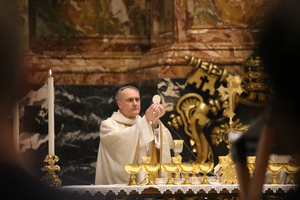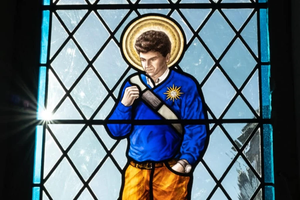What Our Lady of the Fatima Taught Us About the Rosary
ROSARY & ART: Our Lady asks for recitation of the Rosary and conversion from sin.

(The Vatican instruction on the message of Fatima can be seen here.)
One of the best-known modern apparitions of the Blessed Virgin Mary occurred at Fatima, in Portugal, in 1917, on the 13th day of each month for six months, from the Marian month of May through the month of the Rosary in October. Our Lady appeared to three Portuguese children: Lúcia dos Santos (1907-2005), Blessed Francisco Marto (1908-1919), and Blessed Jacinta Marto (1910-1920). Both children succumbed to the “Spanish flu,” the influenza pandemic of 1918-20.
The apparitions at Fatima took place in the last years of the First World War, the great convulsion that took almost 40 million lives, including 9-11 million military personnel. At Fatima, Our Lady asked for repentance and that people pray the Rosary daily for world peace. At her very first appearance in May, Our Lady held a Rosary in her hands.
Our Lady also called for devotion to her Immaculate Heart, and later (in an apparition to Lúcia) outlined the “Five First Saturdays of Reparation,” i.e., to go to Confession before and receive Communion on five consecutive first Saturdays, reciting the Rosary, spending 15 minutes in meditation on the mysteries of the Rosary, and offering these actions in reparation for sin. Our Lady promised to help those who keep the devotion at the hours of their deaths “with all the graces necessary to save their souls.”
In the course of the appearances at Fatima, Our Lady also asked that the following prayer precede each of the decades of the Rosary: “Oh my Jesus, forgive us our sins. Save us from the fires of hell. Lead all souls to heaven, especially those most in need of thy mercy.” During her appearance in July 1917, she indicated that God wants to establish devotion to her Immaculate Heart and gave the children a vision of hell, the poor outcome of those who will not repent and for whom there is no one to make spiritual sacrifices for their conversion.
The Fatima appearances ended Oct. 13, 1917, with the “miracle of the sun,” an event witnessed by at least 30,000 people, where the sun appeared to detach itself from its place and careen toward earth. “Our Lady of the Rosary” continued to ask for recitation of the Rosary and conversion from sin. It’s an appropriate anniversary to remember these days.
(In 1877 when Our Lady appeared in Gietrzywałd, Poland, she also asked for daily Rosaries and, as she had earlier in Lourdes, identified herself as the Immaculate Conception, clearly a preferred title: see here.)
I know of no formal paintings of Fatima: typically, there is popular art depicting the children visionaries or statues of Our Lady of Fatima according to the children’s description. This is not unexpected: classical religious art has not been a particularly strong suit of 20th-century art.
Because of Our Lady’s focus on praying the Rosary, however, I will focus on artistic depictions of Our Lady of the Rosary. The theme was particularly popular among the great artists of Spain, including that country’s master Baroque artist, Bartolomé Esteban Murillo (1617-1682). This painting is in Madrid’s Prado Museum.
Murillo’s depiction of Mother and Child is typically Baroque, especially Spanish Baroque: physically imposing figures against a dark, even black background. That Christ Child is quite large for a pre-toddler, but he is not seated: rather, standing on his Mother’s lap allows them to be cheek-to-cheek. Strong, powerful colors — red and blue — set against that dark background also enhance the contrast. Simple beauty marks the two figures, enhancing the sense of their holiness.
She sits on a bench, elevating them both above us. Both Mother and Child share a Rosary between them, each holding it with their right hand. They don’t finger the beads because they are not praying: they are recommending it to you.
Murillo had deeper theological insights than some moderns. I’ve heard even nuns and priests babble about “not confusing your Marian mysteries and your Christological mysteries” or “not mixing up devotion to Jesus and Mary,” especially when people pray the Rosary in front of the Blessed Sacrament. Don’t fall for that! The Rosary focuses on the life of Christ, seen through the eyes of the person dearest to him, the person most intimately part of his life, his most committed disciple: his Mother. To make such “distinctions” is theologically unwarranted and probably suggests some other agenda than a sound theology and spirituality.
As Murillo powerfully shows, the Rosary joins Jesus and Mary together, and both are looking right at you to see if you will be weaved into that picture, whether you will give it a three-fold, quasi-Trinitarian dimension by joining your person to theirs.
Will you? May is a good time for that, especially on our Lady of Fatima’s urgings.
- Keywords:
- rosary
- rosary & art
- our lady of fatima
















